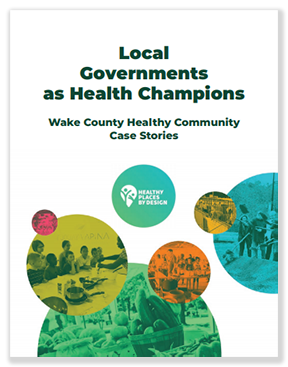Local Governments as Health Champions
The Wake County Healthy Community Initiative
During a time when public confidence in government is low, six municipalities in Wake County, NC, have demonstrated that local governments can still have a profound effect on their communities’ health. In fact, healthy communities cannot exist without the support of local governments and local leaders who are committed to change. This is exactly what we saw, and who we worked with, through the Wake County Healthy Communities (WCHC) initiative.
Funded by the John Rex Endowment from 2014-2018, the goal of the WCHC initiative was to improve policies and change the built environment to increase children’s access to healthy food and active living opportunities in Wake County, NC. The thinking behind the initiative was simple: if local government increased access to healthy opportunities for those who are most vulnerable, the whole population would benefit.
Healthy Places by Design provided technical assistance and coaching, and also created a learning network of the six municipal grantees and their partnerships with support from Advocates for Health in Action. Regular networking activities included face-to-face convenings that emphasized capacity building, strategy-specific content, and peer learning. We recently developed and published Local Governments as Health Champions: Wake County Healthy Community Case Stories to lift the phenomenal work and commitment to health from the municipalities and their partners.
As Healthy Places by Design reflected on that work, we identified four key lessons. To read more about each of these lessons and to explore what the six municipalities achieved, explore the final report.
 Collaborative learning: Collaboration was key to success in each community. Project leaders and other staff stated that group learning and interaction with other municipalities led to new areas for professional development, and that the WCHC initiative advanced their knowledge.
Collaborative learning: Collaboration was key to success in each community. Project leaders and other staff stated that group learning and interaction with other municipalities led to new areas for professional development, and that the WCHC initiative advanced their knowledge.- Flexibility: In many cases, the municipalities’ initial plans required adjustments due to staff turnover, small changes in municipal priorities, and unexpected or unfeasible emerging constraints. In all cases, however, the partnerships adapted to external changes to stay on track.
- Sustainability: From the beginning, Healthy Places by Design worked with the municipalities to plan beyond the three-year initiative and consider whether their strategies could be sustained to have a lasting, positive impact on the community. From creating new line items in budgets to building new infrastructure, each municipality found ways to answer this question with an enthusiastic “yes!”
- Champions: Visionary leaders help others see beyond the status quo. The WCHC initiative revealed emerging leaders and emboldened established ones, giving them a platform to do more and go farther with health strategies that would benefit everyone.
And as I have personally had time to reflect on our organization’s role in this initiative, a few other important takeaways emerged for me:
- Adjusting to the pace of government is unavoidable. This isn’t news to anyone, but local government often moves slowly. It’s important to remind partners that changes to policies and built environments take time, and that initiatives such as these need multi-year support. Although this work is urgent, and these changes never seem to happen quickly enough, it’s important to reassure advocates that they don’t have to get discouraged when a government process takes longer than hoped. Embracing the (slow) rhythm of government means that there are opportunities for work that can happen in tandem with the main objectives. For example, Raleigh’s Parks and Recreation Department explored partnering with a national organization to work on an internal wellness policy while waiting for city attorneys to review a shared use policy.
- There are creative ways for local government to address food access. New farmers’ markets, even if they accept SNAP/EBT benefits, may not be the best single strategy to address food insecurity in every community. We found that there may not be enough vendors who want to sell produce at multiple markets. While farmers’ markets are often attractive economic development strategies, municipalities that are primarily committed to addressing healthy food access can find complementary solutions. For example, in addition to Zebulon’s Farm Fresh Market, the town also partnered with a nonprofit and church to support their food pantry with donated local produce for low-income residents.
- Local governments naturally gravitate to win-win solutions. Government spending, even at the local level, comes under intense scrutiny each fiscal year, and budgets are often tight. The Wake County Healthy Community initiative gave health champions who are working within government an opportunity to test creative, evidence-based strategies that address multiple issues. From our perspective, this initiative was focused on health. But for some local leaders, the initiative was important for other reasons like economic development, education, safety, and transportation. For example, Morrisville leaders created a new space in the emerging downtown for a farmers’ market, community garden, and possible “third space” across from the Indian Creek Greenway and Trailhead. This work not only addressed food access, but also strengthened an economic vision of a lively downtown.
It was a privilege to work with so many community leaders across Wake County and to highlight the stories of how municipal staff, managers, and elected officials became stronger champions for health in their communities. Each municipality is now poised to sustain and potentially expand beyond the original healthy eating and active living goals to support a broader understanding of health as a community priority.